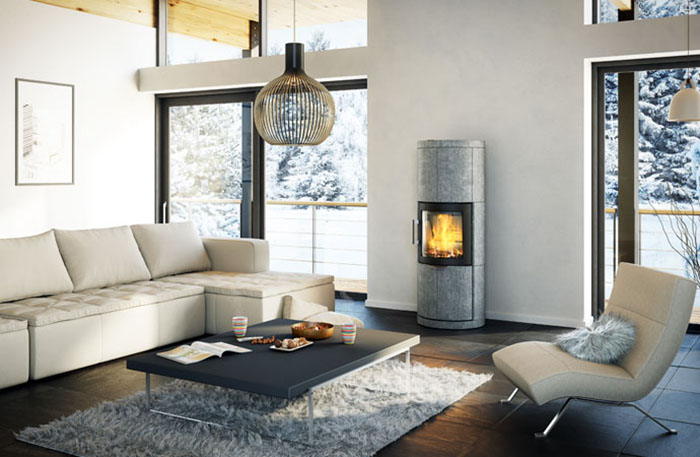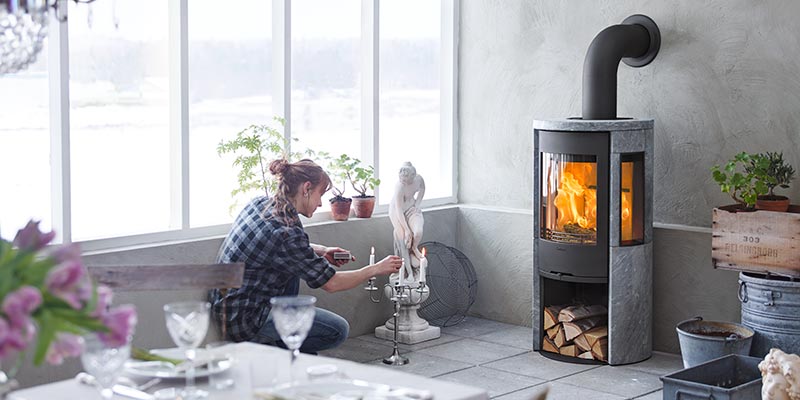While many wood-burning stove owners will have their own tips and tricks to maximise heat output, the process is fairly straightforward and in many ways a scientific approach does best. Whether utilising the draft to light your fire, using the right type of wood or simply maintaining your stove, there are ways and means of maximising your heat output, reducing fuel costs and extending the life of your stove.
Air control
When you think about it, fires do not burn in a vacuum therefore it goes without saying that air control is an integral part of maximising fuel efficiency. When starting your stove in the morning, many people fully open the draft control which lets air in. You may need to reduce the amount of air entering your stove once the “fire has caught hold” but in the early days the draft will certainly help. It is also worth noting that once the stove is burning it is the amount of wood not the air control which will regulate the temperature.
Clean your wood-burning stove
Aside from the fact that a clean wood-burning stove will be more durable and long-lasting it will have an impact upon the efficiency of the wood fuel you use. This means that not only should the stove body, and in particular the combustion chamber, be cleaned on a regular basis but the chimney should be swept and the flue inspected. On their own, these elements of a clean stove and flue pipe may not have a massive impact but cumulatively they can. So, clear out the soot, ashes and have your chimney swept on a regular basis – it will pay for itself in the long run.

Reading smoke signals
Interestingly, some people believe that smoke is in effect the “exhaust fumes” from your wood-burning stove. Scientifically this is wrong. Your wood-burning stove will only create dense black smoke when it is not burning at optimal levels which can be impacted by relatively moist wood. When your stove is burning at optimum levels there will be some fumes escaping to chimney but these tend to be relatively light and odour-free – as opposed to the thick dense black smoke described above. How can you monitor these smoke signals? Simple, run outside and see what is coming out of your chimney/flue outlet.
Turbulent airflow
As we touched on above, any stove requires air as part fuel to ignite the logs and keep them burning. You will notice that many people keep their stove door open during the initial lighting process. This creates turbulent airflow and ensures that the hot gases are effectively bombarded with oxygen which ignites creating a stronger flame and more heat output. Such is the obsession with airtight homes today that on occasion stove enthusiasts have been forced to open windows in their home to create a more turbulent airflow. Obviously, you don’t want air turbulence the force of a hurricane!

Individual logs will burn out
It is amazing what science brings to the stove industry. Research has shown that adding one log at a time to a burning stove is near enough useless. This will interrupt the three stage burning process and mean that you are running backwards and forwards with individual logs much quicker. When adding more than one log (it is advisable to add two or 3 at a time) this not only gives more fuel to burn but also creates an expanded surface area. This “terrain” is perfect for creating turbulent airflow which as we mentioned above assists with the burning process.
Moisture levels
Before we look at moisture levels it is worth noting that where you have hardwood and softwood of the same volume the hardwood will last longer and create more heat. The reason – simple, hardwood is much denser than softwood therefore there are more particles to burn for the same volume.
If we now turn to moisture levels, the general consensus is that you should only burn fuel with a maximum moisture level of 20%. Anything above and beyond this level will impact the efficiency of the wood you burn; heat produced and can also create a tar-like material which can cause major problems with your flue pipe and chimney. There are no shortcuts to drying wood but you should never be tempted to use wet wood!

